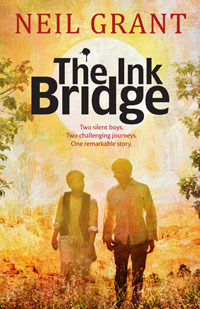 So says a character in this Australian YA fiction title, honored by The Children’s Book Council of Australia, but, she said it, full of cryptic. The Ink Bridge tells the story of two young men, one Afghani named Omed and one Australian boy named Hector, Hec for short. Omed’s story comes first in the book. Maimed by the Taliban when they cut out his tongue, Omed is unable to talk, lost inside himself, and a lot of his internal dialogue is obscure and puzzling (cryptic) to say the least. Omed’s story is the tale of a refugee with very little hope, as Omed makes his way from Afghanistan to Australia in the clutches of and dependent on an evil smuggler called The Snake.
So says a character in this Australian YA fiction title, honored by The Children’s Book Council of Australia, but, she said it, full of cryptic. The Ink Bridge tells the story of two young men, one Afghani named Omed and one Australian boy named Hector, Hec for short. Omed’s story comes first in the book. Maimed by the Taliban when they cut out his tongue, Omed is unable to talk, lost inside himself, and a lot of his internal dialogue is obscure and puzzling (cryptic) to say the least. Omed’s story is the tale of a refugee with very little hope, as Omed makes his way from Afghanistan to Australia in the clutches of and dependent on an evil smuggler called The Snake.
Halfway through the book, the point of view switches to Hec, another boy without words. Hec is an elective mute; he chooses not to talk because the tragedy which has occurred to disrupt his life has sucked all the words out of him. As he gets to know Omed, however, whom he calls Silent Boy, Hec finds a reason for words and telling stories. In fact, he finds himself compelled to tell Omed’s story in the hope that somehow telling the story of Omed’s struggles will give voice to the suffering people of Afghanistan and will change in some small way the tragedy that is being played out daily in that country.
A lot of the book fits the cryptic label. Omed and Hec both are very internally focussed for much of the story. Since they can’t or won’t talk, they imagine a lot, and some of their introspection is a stew of secrets and mysteries and regrets and visions and just plain craziness. I can imagine not talking for a year, like Hec, and sometimes I think it would be a relief. But it might make me a little more crazy than I already am.
The Ink Bridge is a book about the power of words, but I think it would take a motivated and discerning young adult reader to stick with the story through the enigmatic passages and the difficult relationships that make up the bulk of the narrative. I would recommend it to those who have an interest in refugees in Australia or in the people of fghanistan.
